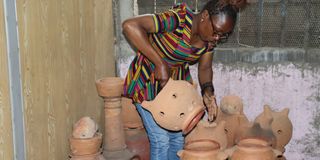Biz Lounge: Desire to help chicken farmers births witty brooding pots idea

Sheila Khayi arranges the pots at her shop in Nakuru city on September 6, 2024.
In the age of mass-produced incubators and high-tech poultry farming equipment, one entrepreneur is turning heads by reviving an ancient practice that has sustained rural communities for generations.
Sheila Khayi, an entrepreneur, is making waves in the agribusiness sector with her innovative approach towards crafting traditional clay brooding pots.
Having grown up moulding these pots, even during playtime as a child, she brings a lifetime of experience to her business.
She tells Mtaa Wangu that after observing the high mortality rates in chick rearing, in urban areas especially during the pandemic, she saw a chance to introduce the pots, initially used for cooking back home in Kakamega and to warm their houses and rooms, to a modern problem.
“During the 2020 pandemic, a lot of people got laid off and for some reason, most of them got into poultry farming. With limited knowledge about brooding, a lot of them lost their day-old chicks in the process. This marked the beginning of my unique business venture,” says Khayi.
With a mission to help farmers reduce their chicken mortality and cut down their brooding costs, Khayi started with two pots that cost about Sh. 500 and later on injected Ksh. 10,000 in the business after it picked.
“A single pot can help brood up to 300 chicks and maintain a consistent heat for an astounding 72 hours which has helped farmers cut electricity costs by almost half and reduce their mortality rates by almost 90 percent from a 70 percent loss,” says the former sales and marketing associate.
She says her primary customer base consists of other businesses (B2B), and its growth has largely been driven by word-of-mouth recommendations and referrals from existing clients which has seen her get an increasing and stable profit margin of about 75 percent.
“From these referrals, I also got clients who asked for customized products which made us diversify from brooding pots to now the modern woman clay pot, that can be used on gas or with electricity, chimneys, energy-saving jikos, piggy banks, and water tap clay pots,” Khayi notes.
The sizes of these pots vary in price with the brooding pots and the modern woman clay pot costing Sh. 1000, the chimney cost between Sh. 1500-2500, the piggy bank Sh. 200 whereas the water tap clay pot prices depend on the 40-litre pot going for 3500, 20-litre Sh. 3000 and the 10-litre for Sh. 2500.
In six years, Khayi has been able to bring on board 5 permanent employees and 15 employees on contract with 75 percent being women and 25 percent men.
This she says is her way of using pottery to give back to her society that has long struggled with vices like crime, early pregnancies, abortions, alcoholism conflicts, and deforestation in Kakamega forest.
“My biggest challenge,” she says, “has been transporting the pots from Kakamega to Nakuru due to their fragility. We are still in search of specialized form to transport the goods more safely. The lack of ideal packaging has often led to some losses due to breakages during transit.”
While it seems easier to make the pots here in Nakuru than to transport them all the way from Kakamega, Khayi says the nature of the soils in Nakuru has not proved suitable for this.
“We're still in the process of fully establishing our business here in Nakuru. However, our biggest challenge has been the clay quality. The clay in Kakamega is of unmatched quality compared to what's available in Nakuru."
She continues, "Transporting this high-quality clay is extremely bulky and expensive. That's why our production currently happens in Kakamega. We're actively exploring creative and more affordable ways to bring the production process to Nakuru, but it's a complex challenge we're still working to solve.”

